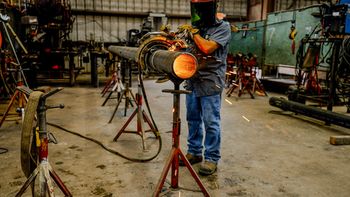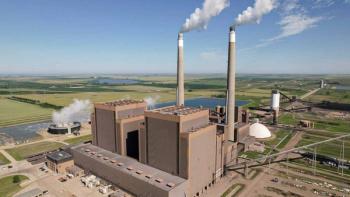
How about a new reheat gas turbine?
This is the first part of a series by the author where he discusses GE’s takeover of Alstom GT business and GE’s challenge of profitability. In his upcoming articles, he talks about a proposed design for reheat combustor and how GE could redesign the Alstom/ABB reheat gas turbine.
GE was given the green light by the French government to acquire the French gas turbine part of Alstom in November this year after a fierce fight over the company by both MHI and Siemens. GE won the contest in June, but the French government held up the merger and insisted that GE would not decrease French employees after the takeover. GE's CEO Jeff Immelt personally took charge of the negotiations and came up with a 16.9 billion dollar deal in two parts that satisfied the French. The deal was closed.
Alstom's GTs came out of the previous ABB company that was formed out of the Brown Boveri Swiss company, the grandfather of all gas turbines. Its first industrial unit had a rating of 4000KW and was first run in 1937. Its axial flow compressor was applied by Dr. Hans von Ohain of Germany for the first axial flow jet engine.
GE now has the job of forming review teams to advise them on what to do with the ABB designed reheat (sequential combustion) 60 Hz GT 24 and 50 Hz GT26 gas turbines. ABB decided to develop in secret these designs to compete with the Westinghouse 501 D 100 MW unit and the new GE Frame 7F. The first GT 24 was installed on the East coast of the US. GE sold a number of its 7F units and placed them into operation in the US before running into serious rotor cooling troubles. Then ABB did the same thing and got into rotor cooling problems also. Both companies spent considerable money and field time getting out of trouble, but they did so. Alstom/ABB has sold many of the reheat units around the world and has been very successful with this design. The reheat design has distinct part load efficiency advantages over the simple cycle GTs and a potential higher CC efficiency.
Now with the GE takeover of Alstom's GTs, the big question is: what will GE do with all of the ABB/Alstom GT designs which are in competition with the GE units, especially the new 9HA and the 7HA models? Will they be dropped? Then there is the question about the all welded stiff rotors originated and developed by ABB that have made the 24 and 26 designs possible. What will GE do with this technology? At the same time, GE faces the challenge of profitably using the large GT manufacturing plant in Baden, Switzerland and the test facilities nearby.
Now there are only three players in the World HD GT business, they being first of all GE followed closely by Siemens and MHI.
Closed loop steam cooling
GE in its latest sales brochure on the 7HA GT indicates that the closed loop steam cooling system, called the ‘Rice Cycle’ by some GT experts, has been very successful over the past 10 years and this experience has been the basis for developing the new high TIT air cooled 9HA and 7HA designs. This would indicate that GE has not given up on the closed loop steam cooling system for CCs. MHI still uses this cooling scheme on some of its latest CC GTs to cool the combustion zone and the transition ducts. Air cooling offers a faster CC start up and greater operating flexibility, but the power output is a little less.
The author has on several occasions suggested to Alstom/ABB that the closed loop steam cooling system be applied to the reheat GT24 and 26 units as a way to increase the two TITs and thus increase power output and CC efficiency. The RH units require more cooling for the RH combustor and the power turbine which has been a handy cap to overcome. Thus steam cooling was suggested. However, it would have cost them a lot of money to redesign these RH units, money they did not have.
The GE study teams should consider recommending keeping the Alstom/ABB RH design because GT reheat thermodynamically offers a greater power output and a higher thermal efficiency as was recognized by GE in the case of the steam turbine when it went to steam turbine reheat many years ago. When considering keeping the reheat GT design, GE should also study the use of more ceramic parts GE is pushing coupled with closed loop steam cooling and also high flowing the compressor as it has done on the new 7 and 9 HA units to increase power output. The pressure ratio could be raised to 40 or higher to better suit the RH cycle using the latest technology available today.
There is one more change I would suggest and that is the Alstom/ABB rather high pressure loss and lengthy axial requirement of the reheat combustor. ABB developed and patented a unique reheat combustor design for its 24 an26 GTs. The temperature rise of the reheat combustor is about half that of the first combustor and requires about half the amount of fuel. On the other hand, the afterburner of the jet engine has a much higher temperature rise and required considerably more fuel. Therefore, the GT reheat combustor can be quite different in design than either of other two.
In the next part of this series, the author discusses the ABB reheat combustor, and proposes a new reheat combustor design to increase CC efficiency.
(Ivan G. Rice was past chairman of the South Texas Section of ASME (1974 - 75), past chairman of the ASME Gas Turbine Division (now IGTI) (1975 - 76). A Life Fellow Member of ASME and Life Member of NSPE/TSPE, he has authored many articles and ASME papers on gas turbines, inter-cooling, reheat, HRSGs, steam cooling and steam injection.)
Newsletter
Power your knowledge with the latest in turbine technology, engineering advances, and energy solutions—subscribe to Turbomachinery International today.




